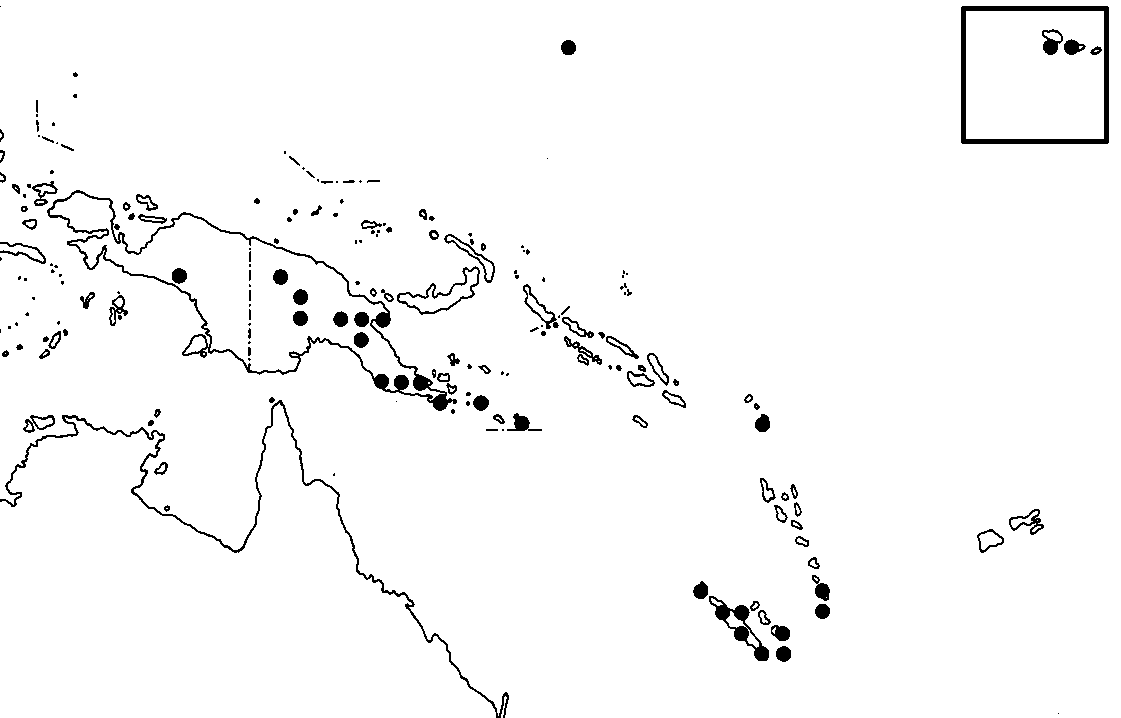
For descriptions and extensive additional synonymy see Barlow, Austral. J. Bot. 22 (1974) 564, 566 under A. aneityensis and A. artensis; Danser, Bull. Jard. Bot. Buitenzorg III, 11 (1931) 323, 344 under A. bamleri and A. gracilis; Danser, ibid., 14 (1936) 88, 89 under A. aneityensis and A. artensis. Amyema artensis has few specialized characters other than the very few-rayed umbel, and thus presents a relatively generalized facies for the genus. The most common form of the species can be identified locally by its combination of decussate distinctly bifacial petiolate leaves, 2-rayed umbels, triads with the central flowers sessile and lateral flowers pedicellate, and 5-merous flowers. However, the species is relatively polymorphic, and forms with temate or quatemate leaves and/or 3- to 5-rayed umbels are common, as well as others in which the lateral flowers of the triads are more or less sessile and/or the umbel rays are concrescent so that the inflorescence is capitate. The flower colour is described as various shades of red, pink, or orange, and frequently red or bright pink in the lower part and orange, yellow, or paler pink above.
The species is distributed from New Guinea to several island groups
in the southwest Pacific, including the Solomons, Louisiades,
New Caledonia and adjoining islands, Vanuatu, Caroline Islands,
and Samoa (fig. 2; 105 collections seen). On the New Guinean mainland
the species usually occurs at elevations from 1500 to 2500 m,
but has been recorded from 1190 to 3400 m. In the other island
groups it appears to range generally from sea level to the highest
elevations which exist. Apart from the specimens previously placed
in A. aneityensis and now included in A. artensis (see
below), additional collections seen in the present study have
not extended the known area. In New Guinea the species has been
recorded from primary and secondary rain forests, parasitic on
numerous different hosts, and in the other island groups from
humid and gallery forests, again parasitic on various hosts.
Amyema artensis shows distinct morphological and ecogeographic
links to other species of the Papuasian region, especially A.
novaebritanniae and A. pachypus. Together these species
form a complex which has probably diversified extensively during
the genesis of landforms in the region. Amyema novaebritanniae
is endemic to the Bismarck Archipelago, and thus has a geographic
replacement pattern with A. artensis. The two species differ
consistently, but in relatively minor characters of leaf texture
and inflorescence structure. Perhaps of more significance is the
link from A. artensis to the species of the subalpine zone
in New Guinea, exemplified by the sympatry but altitudinal separation
of A. artensis and A. pachypus, and the approximate
geographic replacement pattern of A. artensis and A.
wichmannii (see below). Amyema artensis is notable
in the family for its wide distribution to remote islands (exceeded
only by Decaisnina forsteriana which ranges from the Solomon
Islands to Tahiti), and the polymorphy of the species complex
is probably in part a consequence of its disjunctions.
The subalpine species A. pachypus occurs within the geographic
range of A. artensis in New Guinea, but at generally higher
elevations. With increasing elevation A. artensis shows
increasing similarity to A. pachypus, especially in the
smaller leaves and shorter, thicker, more strongly articulated
inflorescence parts. However, these variations may be largely
influenced by environment, and A. pachypus remains distinct
in its 4-merous flowers and bracts constricted below the apex.
Further eastwards, at higher elevations in the Milne Bay District
of New Guinea, A. artensis shows considerable variability
in inflorescence characters and a closer resemblance to the subalpine
species A. wichmannii. This may also be an environmentally-induced
parallel variation, because there is no geographic contact between
the two species, and intergradation is unlikely. The specimen
from the highlands of the Milne Bay District distinguished by
Barlow (1974) as A. wichmannii subsp. aggregata is
therefore probably misplaced in this species. Along with several
other specimens from the area, it is distinctive in having 4 or
5 rays in the umbel and sometimes a very weakly dilated apex of
the peduncle, but this is probably a local extreme of variation
in A. artensis rather than a disjunct differentiate of
A. wichmannii. Amyema wichmannii subsp. aggregata is
accordingly placed in synonymy with A. artensis. Amyema wichmannii
differs from A. artensis in having 6-12 rays in the
umbel and 4-merous flowers.
Danser (1936) and Barlow (1974) both accepted A. aneityensis
as a distinct species, but with comments on its close affinities
with A. artensis. Amyema aneityensis is distinguished primarily
on its normally quaternate phyllotaxy and correspondingly greater
number of rays in the umbel. Re-examination of the variation patterns
in the present study has shown that ternate and occasionally quaternate
phyllotaxy occur through much of the range of A. artensis,
and that umbels with more than 2 rays are similarly of frequent
occurrence. As suggested by Danser, A. aneityensis is apparently
only a local form of A. artensis in Vanuatu.
Re-examination of the variation patterns in the present study
has also shown that the narrow and acuminate-leaved form I distinguished
previously as var. papuana (based on Amyema papuana
Danser) has no geographic integrity, and may be only a juvenile
state. It is therefore treated as equivalent to A. artensis.
One extreme variant in A. artensis highlights the polymorphy
of some species of Loranthaceae, and the difficulty in circumscribing
taxa and constructing comprehensive keys. A few specimens from
Rossel Island and from New Caledonia show unusual inflorescences
in which the two umbel rays are completely fused longitudinally,
so that superficially the triads appear sessile. There is a correlated
reduction in the pedicels of the lateral flowers of the triads,
so that the inflorescence resembles a capitulum of sessile flowers
not unlike that of the Dicymanthes species group. Whilst
such variations are relatively robust indicators of specific or
supraspecific difference elsewhere in the genus, in this case
they occur mixed with nonnally developed inflorescences on the
same specimen. The occurrence of this variation on both Rossel
Island and New Caledonia suggests that it existed, at least in
lowland populations prior to the dispersal of A. artensis southwestwards
into the Coral sea lands. See note under A. scandens.
The status of A. tenuisepala is doubtful, and it is
included in A. artensis tentatively. The species is based
on a single collection by Ledennann from the Hunstein Mts of New
Guinea, and there appear to be no duplicates of the type, which
is no longer extant. However, Danser (1931) saw the specimen,
accepted the species, and provided a detailed description. The
description generally agrees with A. artensis, but differs
in the 4-merous corolla, 4-rayed umbel, the relatively short inflorescence
axis, and the free part of the staminal filament
Distribution Map (Barlow 1974)

Description
Calyx and sometimes the inflorescence usually shortly brown-tomentose, rarely completely glabrous. Leaves opposite or rarely ternate; petiole distinct, flat above, (3)-5-8 mm long; lamina (lanceolate to) oblong to ovate, (4)-6-9-(14) by (1.5)-2.5-4-(7) cm, shining and frequently red above, dull below, gradually or rarely abruptly attenuate at the base, usually recurved and red at the margins, obtuse or rounded (rarely acute and acuminate) at the apex; venation pennate to almost curvinerved. Inflorescences usually several at the nodes; peduncle (5)-8-20 mm long, slender to robust; rays 2 (rarely 3), 3-6 mm long; pedicels of the lateral flowers (0.5)-1-3 mm long; bracts usually spreading, acute to rounded, c. 1 mm long. Calyx funnel-shaped to urceolate, usually constricted just below the limb; limb truncate, irregularly split or toothed, 0.7-1 mm long. Corolla in the mature bud slender, not or weakly clavate, acute, 20-30 mm long, 5-merous. Anthers c. 1 5 mm long; free parts of the filaments c. 8 mm long. Stigma small. Fruit urceolate to ellipsoidal, crowned by the calyx limb.
Occurrence. Eastern New Guinean highlands, mostly 1500 to 2300 m altitude but occasionally as low as 1000 m. Recorded from one locality in West Irian (Nassau Mountains), 1500 m altitude. Also New Caledonia, New Hebrides, Solomon Islands, Samoa and Caroline Islands (Fig. 4), mostly above 300 m altitude.
Amyema artensis is very polymorphic, varying in leaf size, shape, thickness and pigmentation, and in the dimensions and slenderness of the inflorescence. Specimens with ternate leaves approach A. aneityensis. Within A. artensis one extreme variant has been distinguished at varietal rank.
Key to Varieties of Amyema artensis
1. Lamina lanceolate, 6-14 by 1 5-2-(2 5)
cm, acuminate and acute at the apex 4b. var. papuanum
1. Lamina oblong to ovate, 4-9 by 2-4-(7)
cm, obtuse or rounded at the apex 4a. var. artensis
4a. var. artensis
Lamina oblong to ovate, 4-9 by 2-4-(7) cm, obtuse or rounded at the apex.
Occurrence. Throughout the range of the species (Fig. 4).
Representative Specimens. EASTERN NEW GUINEA: Wabag Subdist., near Poio Village, Yaki Valley, c. 2300 m alt., Irloogland and Schodde 6854, 30.vi.1960 (cANe; L; LAE); Boridi, c. 1500 m alt., Carr 13150, 13298, 14.xi.1935 and 21.ix.1935 (CANB; K; L); Misima Is., Mt. Sisa, N. slopes, 350m alt., Brass 27427, 20.vii.1956 (CANe; K; L). SOLOMON ISLANDS: Santa Cruz group, Vanikoro Is., Emwa, 320 m alt., Whitmore BSIP 1682, 8.iv.1963 (). SAMOA: Upolu, top of Mafa Pass, 300 m alt., McKee 2880, 31.vii.1955. NEW CALEDONIA: Hills above Balade, 300 m alt., McKee 4753, 11.vi.1956 (L). NEW HEBRIDES: Esp. Santo, ridge above and W. of Navaka R. Valley, Chambers 2677, Aug. 1963 (AD).
4b. var. papuanum (Dans.) Barlow, comb. et stat. nov.
Amyema papuana Dans. Blumea 3: 46, illus. Fig. 1, c, d (1938). Type.-Papua, Central Division, Mt. Tafa, 2300 m alt., Brass 4095, 27.v.1933 (L 936139483).
Lamina lanceolate, 6-14 by 1 . 5-2--(2 5) cm, acuminate and acute at the apex.
Occurrence. Mainland New Guinea, recorded from the Owen Stanley Range and Hunstein Mountains, 1800 to 2300 m alt.
Specimens Examined. EASTERN NEW GUINEA: Sepik, Ledermann 9140, 1912-1913 (L); Alola, c. 1800m alt., Carr 13848 and 14106, 17.xii.1935 and 31.xii.1935 (K; L).
The variety is an extreme variant of the polymorphic A. artensis and probably has little taxonomic significance. Intermediate specimens between the variety and the typical form occur.
Intermediate Specimens Examined. EASTERN NEW GUINEA: Upper Dunantina Valley, near Soso
-mepari Village, c. 1700 malt., floogland and Pullen
5309, 11.vi.1956 (CANB; L); Alola, c. 1800 malt., Carr
14135, 2.i.1936 (LAE); Mt. Mon, Milne Bay, 1700 m alt., Cruttwell
1237, 8.viii.1962 (K; L; LAE).
Illustrations
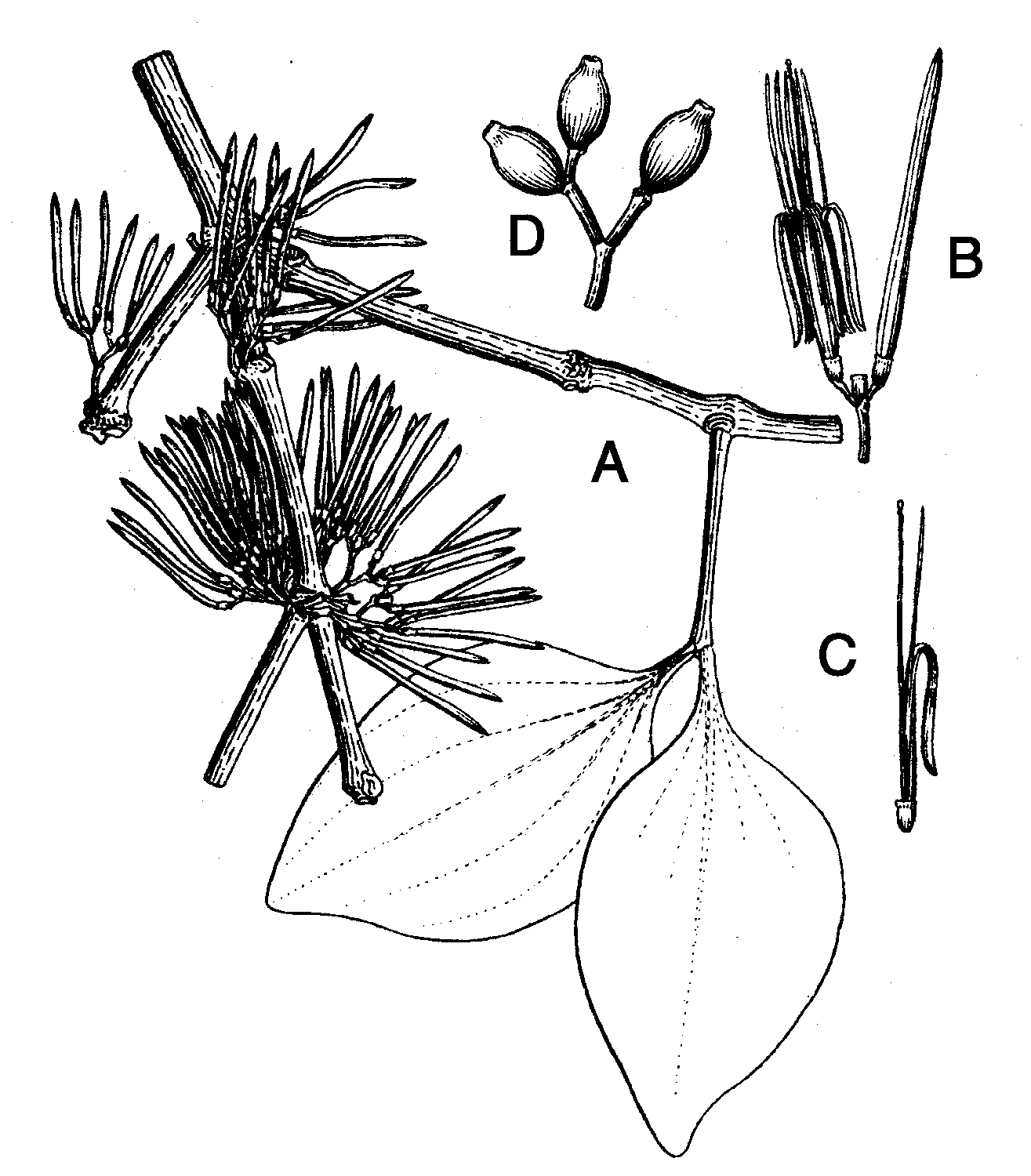
Amyema artensis (as A. bamleri). A - twig with flowers in bud. B - triad. C - calyx with style and one petal with stamen. D - infructescence. From Danser (1931).
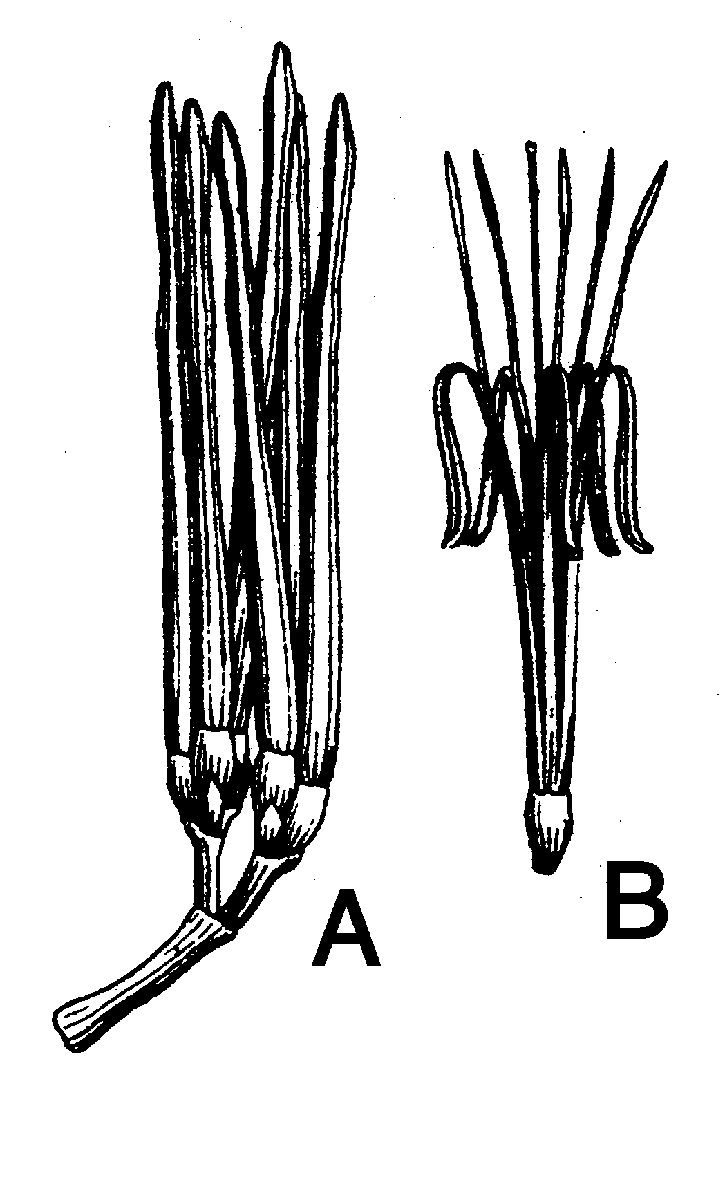
Amyema artensis (as A. gracilis). A - inflorescence. B - flower. From Danser (1931).
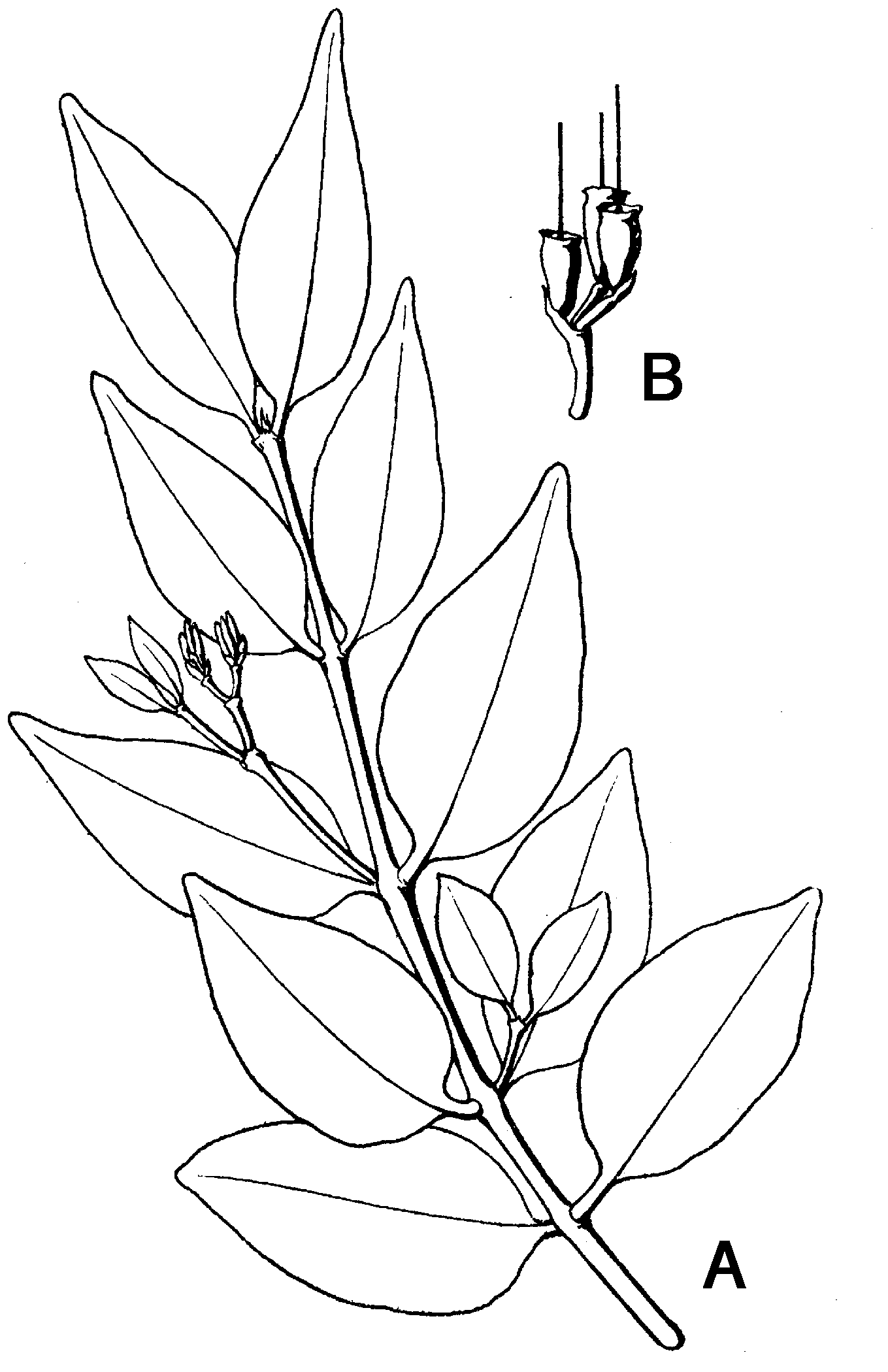
Amyema artensis var. papuanum (as A. papuana). A - leafy twig with inflorescence in bud. B - triad with three calyces. From Danser (1938).
Distribution Map

Description
Amyema aneityense (Guill.) Dans. Rec. Tray. bot. Neerl. 31: 223 (1934); Bull. Jard. bot. Buitenz. 14: 88 (1936); Loranthus aneityensis Guill. J. Ar Arb. 13: 88 (1932). Type.-Aneityum I., Analgauhaut Bay, 50 in alt., Kajewski 753, 12.ii.1929 (NY, holotype, not seen; P; BRI).
Loranthus ficivorus Guill. J. Am. Arb. 13: 89 (1932); Amyema ficivorum Dans. Rec. Tray. bot. Neerl. 31: 224 (1934). Type-Tanna I., Lenakel, 65 in alt., Kajewski 94, 5.iii.1928 (NY, holotype, not seen; P; BRI).
Glabrous except for the inflorescence and calyx shortly and densely brown -tomentose. Stems slender, terete, enlarged at the nodes and much-branched. Leaves mostly in whorls of 4; petiole obscure, up to 8 mm long; lamina ovate to obovate, 4-7 by 1.5-2.5-(4) cm, usually widest above the middle, lustrous or shining above, dull below, attenuate at the base, recurved at the margin, rounded at the apex; venation pennate with the midrib distinct and the other veins faintly visible. Inflores-cences 1-2 in the axils; peduncle c. 10 mm long; rays c. 4, 4-6 mm long; pedicels of the lateral flowers of the triads slender, 1.5 mm long; bracts spreading, acute, 1 mm long. Calyx funnel-shaped, 2 mm long; limb very short and folded inwards. Corolla in the mature bud slender, c. 20 mm long, 5-merous. Anthers 1.5 mm long; free parts of the filaments 7-8 mm long. Fruit nearly globular to ellipsoidal, 6 mm long, crowned by the persistent calyx limb.
Occurrence. New Hebrides and Samoa (Fig. 3), 50 to 700 in altitude.
Specimens Examined. NEW HEBRIDES: Tanna I., Lenakel, 150 m alt., Ka]ewski 87, 3.iii. 1928 (K). SAMOA: Savaii, Matavunu, 600-700 m alt., Christophersen and Hume 1954, 10.vii.1931 (L).
Amyema aneityense is
probably closely related to A. artense, differing in verticillate
instead of opposite leaves and in having correspondingly more
rays in the inflorescence. See note under A. artense.
Illustrations
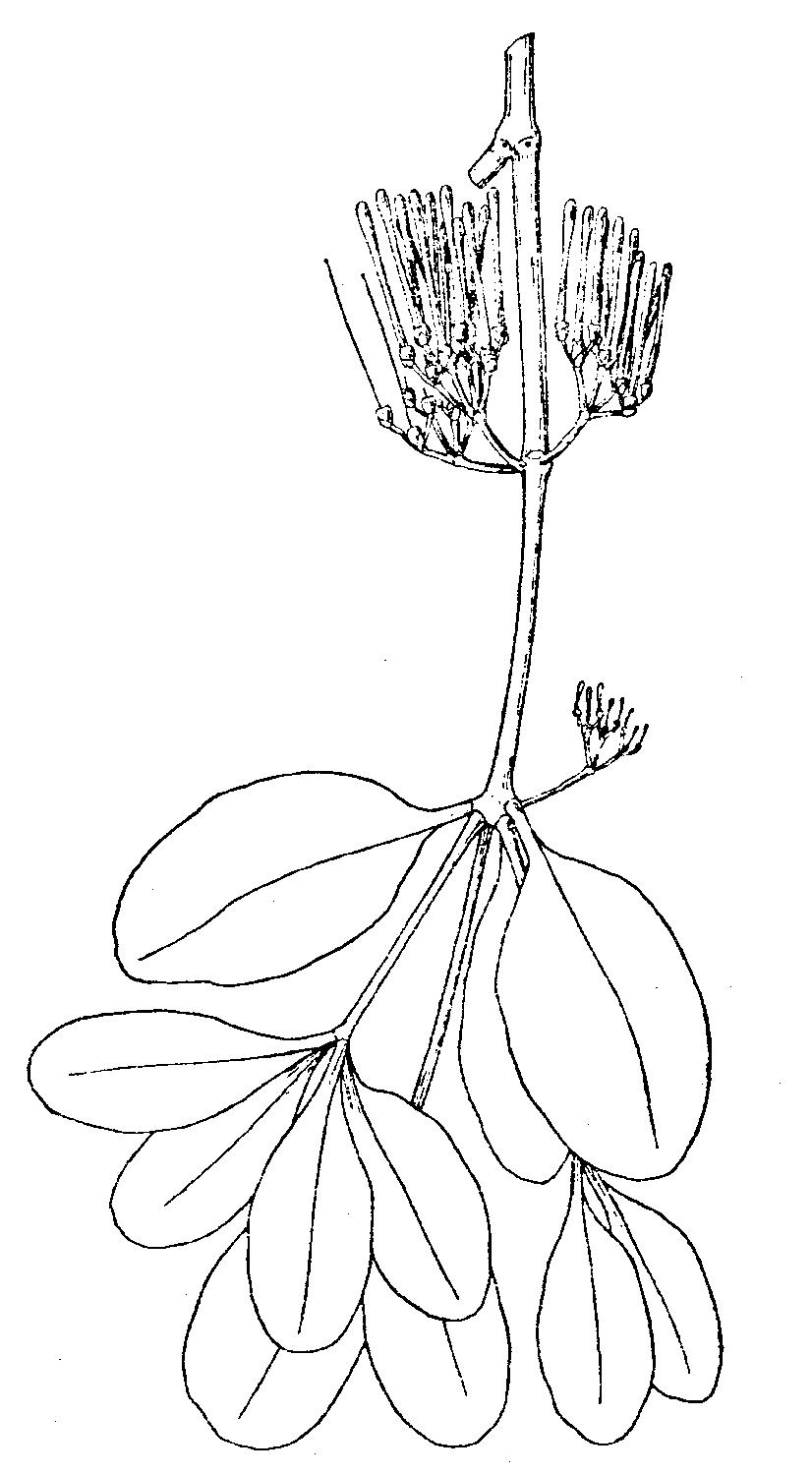
Amyema aneitense. Flowering shoot. From Danser (1934, Misc. Notes 1-6).
Photographs
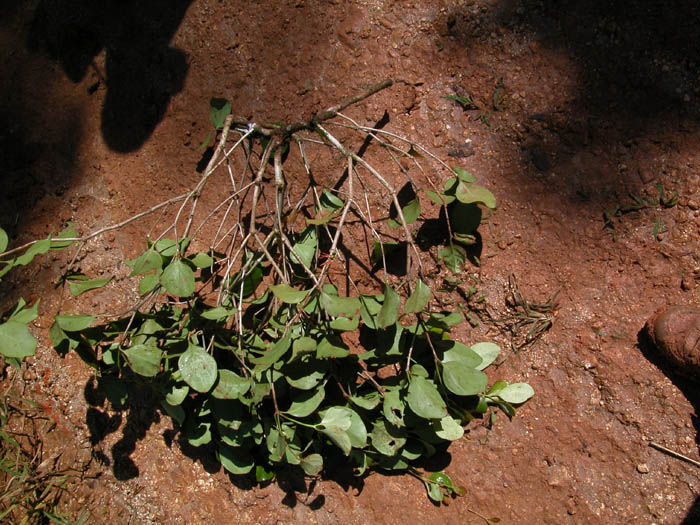
Detached mistletoe [DLN 4472]. Near Nanduo village, Morobe District, Papua New Guinea. Photo by Dan Nickrent.
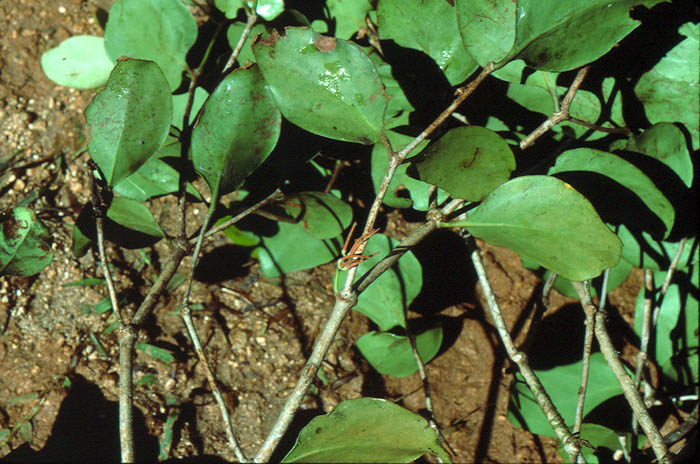
Same as above, closer up. Photo by Dan Nickrent.
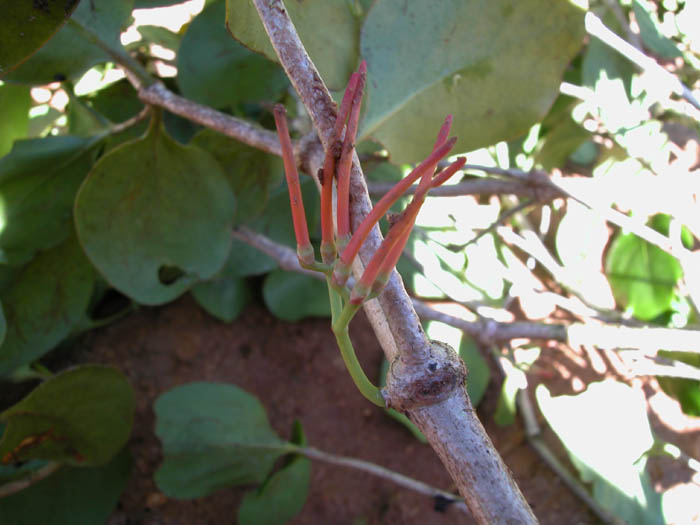
Same as above showing immature inflorescence. Photo by Dan Nickrent.

(DLN 4474). Morobe District, Finschhafen Subdistrict, Papua New Guinea. In village of Sisi. 2311 ft (704 m) elev. Parasitic on Syzygium. Photo. by D. L. Nickrent.
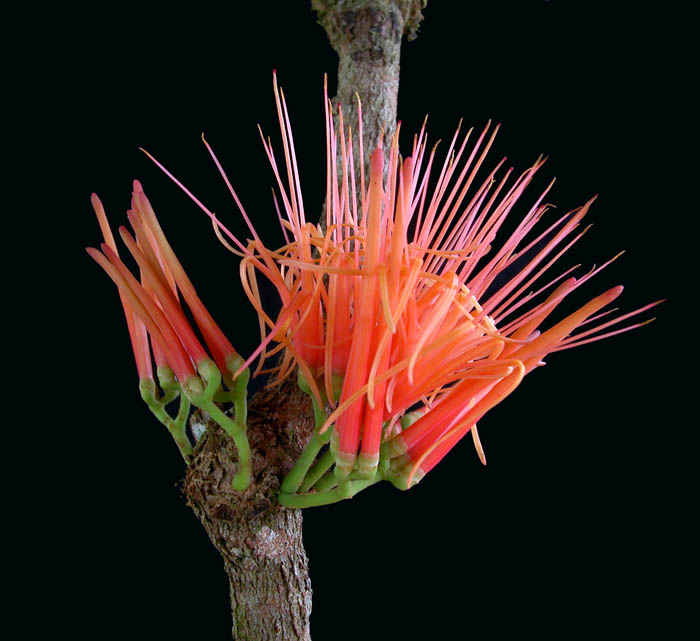
Same as above. Close-up of inflorescence.Photo by Dan Nickrent.
Amyema artensis
updated 17 Jan. 2007